Top 8 Misconceptions About Smart Homes You Should Know
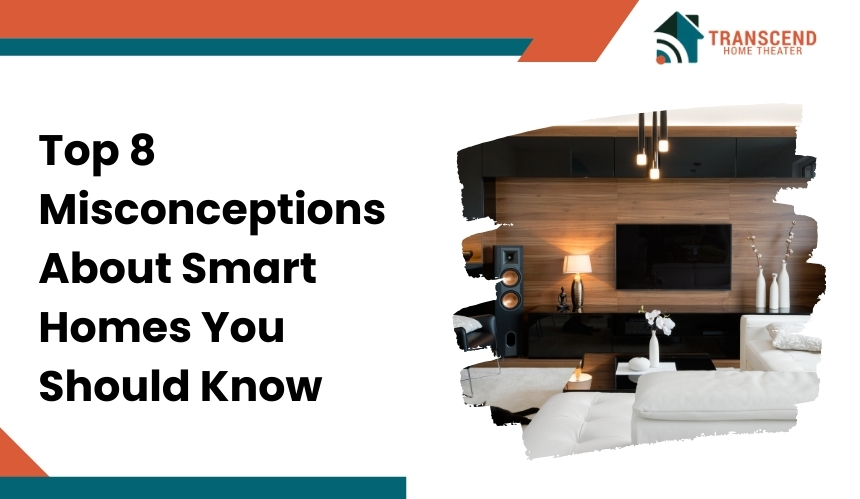
Smart homes are changing the way we live, and they are not as complicated as you might think! From lights that turn on with your voice to thermostats that learn your schedule, smart tech is making everyday life a lot more convenient. But despite all the buzz, there are still a lot of myths floating around that might make you hesitant about jumping in.
Maybe you have heard that smart homes are too pricey, too complicated, or just plain unnecessary. Well, it is time to set the record straight! In this article, we are going to bust the top 8 misconceptions about smart home technology and show you how these gadgets can actually save you time, money, and maybe even a little sanity.
Myth #1: Smart Home Technology Is Too Expensive for the Average Consumer

A common misconception about smart home technology is that it’s reserved for the rich and tech-savvy. People often assume that outfitting a home with smart devices will cost a fortune.
The truth? Smart home devices have become much more affordable over the years, making them accessible to just about anyone. In fact, many smart devices, like smart light bulbs, plugs, and thermostats, are now priced similarly to traditional versions.
These devices often offer long-term savings. For example, smart thermostats learn your schedule and adjust temperatures accordingly, saving you money on your energy bills.
The price of smart tech has steadily dropped, and it’s only getting better. Whether you’re starting with a few budget-friendly devices or gradually upgrading over time, there’s no reason to break the bank.
Myth #2: Smart Homes Are Too Complicated to Set Up and Use
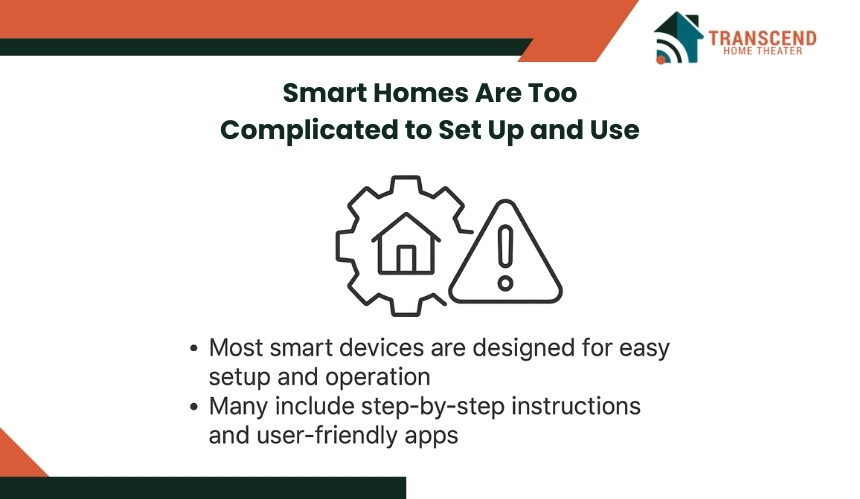
A lot of people believe that smart homes are complex and require a tech expert to set up and operate. The reality is that most smart home devices are designed to be simple and user-friendly.
You don’t need a degree in engineering to install a smart thermostat or pair a smart speaker with your phone. Many devices offer step-by-step instructions and come with easy-to-use mobile apps for control.
For example, devices like smart bulbs, plugs, and thermostats often use plug-and-play functionality, meaning they just work once you plug them in. Even those new to technology can quickly learn how to control these devices through voice commands or mobile apps.
Myth #3: Smart Homes Are Vulnerable to Hacking and Privacy Risks
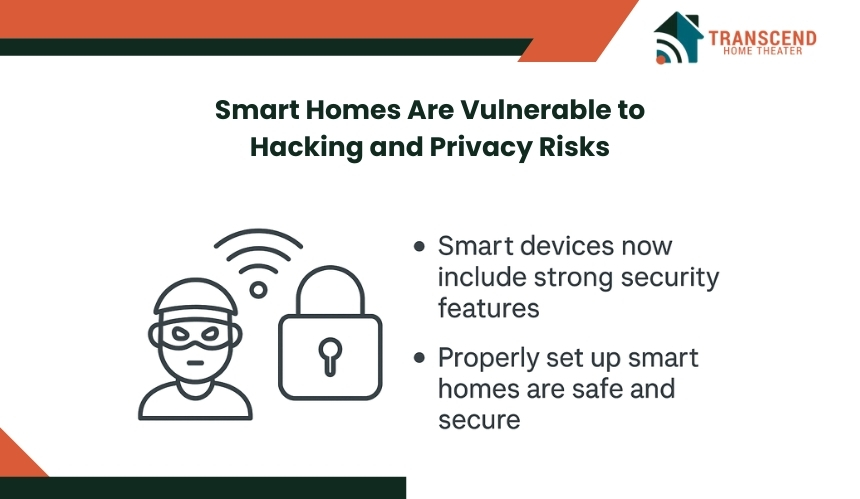
Security and privacy are often at the top of people’s minds when it comes to smart homes, and understandably so. However, the fear of hacking and privacy breaches is often exaggerated.
While smart home devices do need to be secured, advancements in technology have made them far safer than they were a few years ago.
Many smart devices now come with strong encryption, two-factor authentication, and frequent software updates to ensure they stay secure.
A trusted smart home automation company prioritizes security and privacy more than ever, often offering transparent privacy policies and options to control data collection.
Best practices, like changing default passwords and using strong Wi-Fi networks, can further reduce risks. Smart homes just need to be set up securely.
Myth #4: Smart Homes Are Just a Luxury, Not Necessary for Everyday Life
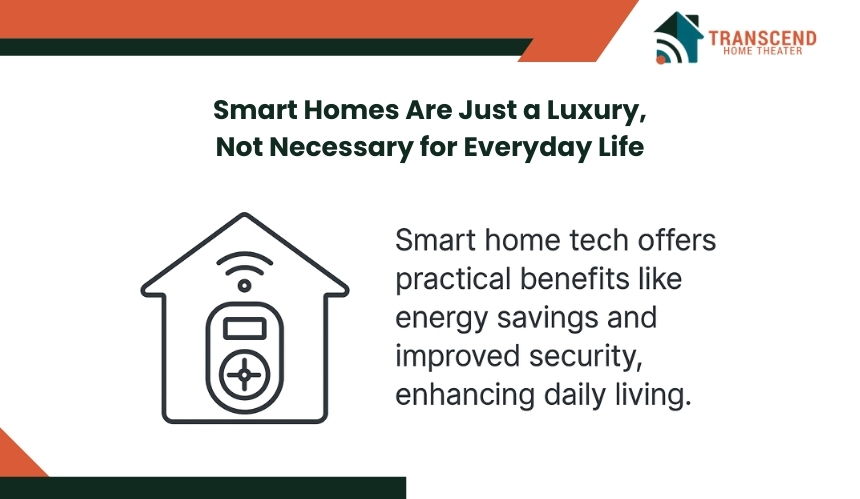
Some might think that smart homes are nothing more than a luxury, offering fancy gadgets that aren’t really necessary. The truth is, smart home technology provides practical benefits that can improve daily life in more ways than one.
For instance, smart thermostats help you save on energy costs by adjusting the temperature based on your schedule, while smart lights can make your home more energy-efficient by automatically turning off when not in use.
Moreover, smart homes can enhance your overall quality of life. From improved security with smart cameras to convenience features like voice-controlled assistants, these devices can simplify tasks and increase safety.
Myth #5: Smart Homes Are Only for Tech-Savvy People
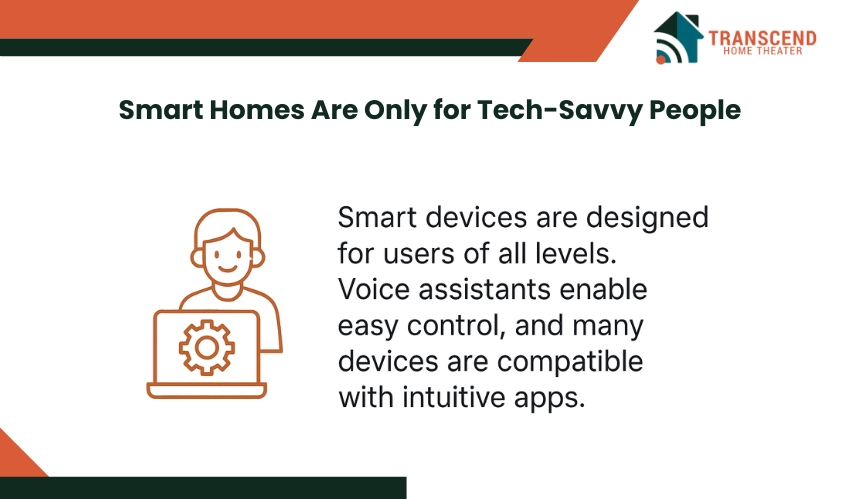
Many people believe that smart homes are meant only for those who are comfortable with technology. This couldn’t be further from the truth. Smart home devices today are designed for users of all levels, from tech experts to those who have never considered using smart tech.
Devices such as voice assistants (e.g., Amazon Alexa or Google Assistant) make it easy for anyone to control smart devices with simple voice commands.
Furthermore, the growing number of user-friendly apps and intuitive interfaces ensures that even the least tech-savvy individuals can enjoy the benefits of smart technology without feeling overwhelmed.
Myth #6: Smart Home Devices Are Not Compatible with Existing Appliances and Devices
A lot of people assume that their existing appliances won’t work with smart home devices. The truth is, many smart home systems are designed to integrate seamlessly with older devices. Thanks to innovations like smart plugs and hubs, it’s easy to make non-smart devices “smarter.”
For instance, you can connect older lamps to smart plugs and control them through an app or voice command. Similarly, you can use smart thermostats with your current HVAC system or sync them with other smart home devices to create an efficient, automated experience.
Myth #7: Smart Home Devices Need Constant Internet Connection to Function
Some people think that smart home devices are useless when the internet goes down, but this is not entirely true. While many smart devices benefit from an internet connection for full functionality, a lot of them can still work without it.
For example, devices like smart lights, smart locks, and security cameras often have local control options that work without internet access. This means you can still turn on your lights or lock your doors, even if your Wi-Fi is down.
The internet primarily enhances the features, like remote control or notifications, but it’s not essential for basic operations.
Myth #8: Smart Homes Are Only About Convenience and Don’t Provide Real Benefits
While convenience is one of the main advantages of smart homes, it is far from the only benefit. Smart homes can also offer significant savings and increased security.
For instance, a smart doorbell with a built-in camera allows you to see who is at your door in real time, even when you’re not home. This provides an added layer of security by alerting you to visitors or potential intruders
Smart security systems provide an added layer of protection by allowing you to monitor your home remotely and receive real-time alerts.
These systems can also integrate with other smart devices to automatically take action when needed, such as locking doors when you leave the house.
Moreover, for people with disabilities or mobility challenges, smart technology can improve independence and quality of life.
Embracing the Future of Smart Home Technology
As we’ve debunked the top 8 misconceptions about smart homes, it’s clear that these technologies are not only accessible but also incredibly practical for everyday life.
Embracing smart home technology means stepping into a more efficient, secure, and connected world. Don’t let myths hold you back from upgrading your home. The future is smart, and it’s here to make your life easier.
Ready to take the leap into the world of smart homes? At Transcend Home Theater, we specialize in providing seamless smart home solutions tailored to your needs. Let us help you build a smarter, more efficient home today. Reach out to us to get started!
Frequently Asked Questions (FAQs)
Can I control all my smart home devices from one app?
Yes! Many smart home devices are compatible with universal apps like Google Home, Amazon Alexa, or Apple HomeKit, allowing you to control all your devices from a single platform. This integration makes managing your smart home convenient and streamlined.
Do I need a smart home hub to connect my devices?
Not necessarily. While some devices require a hub to function together, many smart home devices today work independently or with popular voice assistants like Amazon Alexa or Google Assistant. It depends on the brand and compatibility of the devices you’re using.
Can I use smart home technology in a rental property?
Absolutely! Many smart home devices, like smart lights, plugs, and thermostats, can be easily installed and removed without making permanent changes to a rental property. Just make sure to check with your landlord if you’re considering more extensive installations, like smart locks.
Can I automate my home based on my location?
Yes, geofencing is a feature in many smart home systems. It allows devices to automatically adjust settings based on your location. For example, your smart thermostat can lower the temperature when you leave for work and raise it back up when you’re about to arrive home.
Are there smart home devices that assist with home healthcare?
Yes! There are smart devices specifically designed to support home healthcare. Devices like smart medicine dispensers, fall detectors, and remote health monitoring tools can help individuals manage their health with ease and ensure peace of mind for caregivers.
